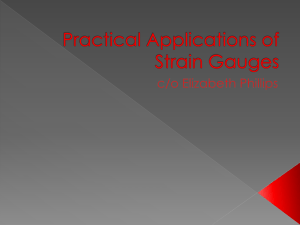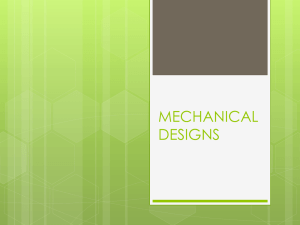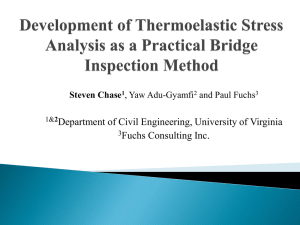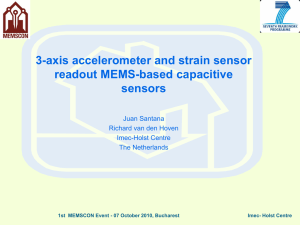Air Bearing Upgrade for Split-Hopkinson Pressure Bar Experiment
advertisement
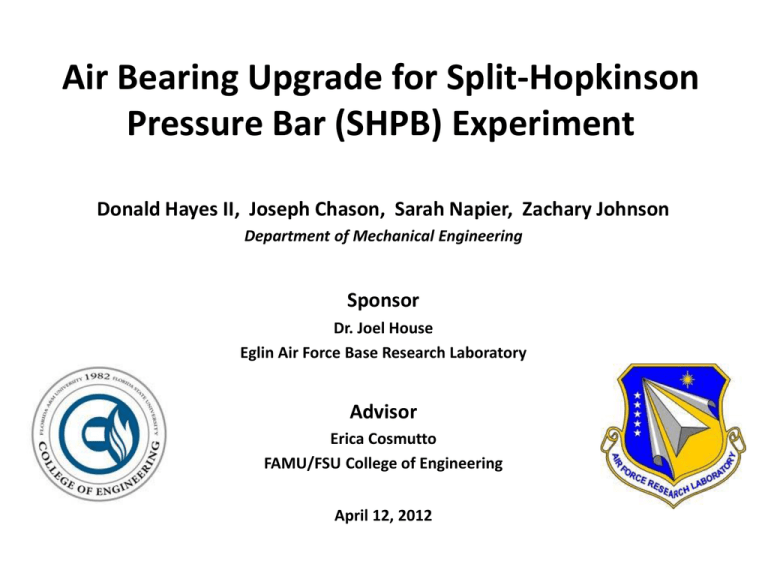
Air Bearing Upgrade for Split-Hopkinson Pressure Bar (SHPB) Experiment Donald Hayes II, Joseph Chason, Sarah Napier, Zachary Johnson Department of Mechanical Engineering Sponsor Dr. Joel House Eglin Air Force Base Research Laboratory Advisor Erica Cosmutto FAMU/FSU College of Engineering April 12, 2012 Overview Introduction Concept Generation & Selection Final Concept Components Functional Diagram Results & Discussion Project Budget Safety Concerns Conclusion Acknowledgements Questions 2 Introduction: SHPB Basics Initial Strain Pulse Striker Mechanism Incident Bar / Strain Gauges / Bushings Reflected Pulse Material Sample Transmitter Bar / Strain Gauges / Bushings Momentum Trap Transmitted Pulse 3 Introduction: SHPB Basics Striker Mechanism Strain Gauges Material Sample Strain Gauges Momentum Trap Data Data Acquisition System 4 Introduction: Needs Assessment Research air bearings for existing 5/8 inch diameter journal bearing system Develop: Bar alignment method System upgrade from journal bearings to air bearings Determine efficiency of air bearings over journal bearings 5 Introduction: Objectives Analyze SHPB design based on use of air bearings Analyze: Hardware cost Interface requirements Installation procedures Impact on bar geometry Assess strain gauge technology Develop procedure to align bars Design a working prototype to show knowledge of system Remain within $2500 budget 6 Generating Concepts: Methodology Break system into base components Treat components as individual systems Generate multiple solutions per system Determine most suitable components Combine and implement into design 7 Generating Concepts: Components & Concerns SHPB Components Base Structure Striker Mechanism Incident & Transmission Bars Strain Gauges Air Bushings Momentum Trap Air Supply System Concerns Bar Alignment Method Data Acquisition 8 Generating Concepts: Criteria Cost Weight Size Simplicity Durability Portability Scalability Accuracy Data Quality Ease of Use 9 Selecting Concepts 10 Selecting Concepts 11 Selecting Concepts Mass Cost Portability Data Quality Simplicity Scalability Ease of use Size Durability Accuracy Score 12 Final Concept Component Final Selection Base Structure T-Slotted Framing Striker Mechanism Electric Solenoid Incident, Transmission & Striker Bars 0.75” dia. 1566 Steel Strain Gauges Foil Type (Vishay Co.) Air Bushings 0.75” ID (New Way Air Bearing Co.) Momentum Trap Custom Gas Supply Compressed Argon Data Acquisition NI Hardware & Software (LabView) Bushing Alignment Method Laser Insert 13 Components: Striker Mechanism Solenoid Striker bar Striker bar tube McMaster Carr 336 ozf. 14 Components: Air Bushings Air line Bushing block housing Air bushing New Way Air Bearings 0.75” Inner Diameter 30 lb. Radial Load 15 Components: Strain Gauges and Material Sample Strain gauges 16 Components: Strain Gauges and Material Sample Vishay Micromeasurements Gauge factor ≈ 2 Resistance = 120 Ω Located 6” from sample Strain gauges 17 Components: Strain Gauges and Material Sample Copper specimen ~ 0.3” diameter ~ 0.3” thick 18 Components: Momentum Trap (bar stopper) 19 Final Concept Incident bar Length = 8 ft. Width = 7 in. Height = 3.5 in. Copper specimen Striker bar mechanism Momentum trap Air bushing Strain gauges Transmitter bar 20 Functional Diagram 120 Volts AC DC Power Supply Wheatstone Bridges Data Acquisition System Data Recording & Storage Activation Switch Striker Mechanism Data Power Gas Incident Bar / Strain Gauges / Bushings Material Sample Transmitter Bar / Strain Gauges / Bushings Momentum Trap Gas Supply 21 Visualizing Sample Strain Pulse:the Visualization Copper Sample Steel Incident Bar Steel Transmitter Bar 22 Reduced Sample Area Strain Pulse: Visualization Increases Applied Stress Dsteel 0.75 in DCopper 0.31 in 23 Visualizing the Strain Pulse Surface: Von Mises Stress Yield Stress σy Copper ½ σy Steel 24 Analyzing Data LabView hardware & software 250 kHz Sampling rate Measured Voltage Calculated Strain Strain Waves Strain Energy Geometric Definitions + Boundary Conditions Material Description 25 Data Acquired 26 Incident Wave Equal to Consequent Waves 27 Elastic Impulse Wave Area ∫dε*dt (s) Incident Reflected Transmitted Strain-Seconds 1.15 x 10-8 4.47 x 10-9 5.46 x 10-9 % of Initial Pulse 100 % 38.7 % 47.3 % "Absorbed" 14 % Low sampling rate error 28 Discussion Potential improvements in system Use of stainless steel bars Potential improvements in testing Annealed copper specimen Higher data rates Used 250 kHz Recommend 1 MHz Implement friction imitation method to evaluate efficiencies between air bushings and journal bearings 29 Project Budget Within budget Total budget $2,500 Total expenditures $2117 Percentage under budget 15% 30 Allocation of Expenditures Striker 2.8% Support Systems 3.0% Frame 3.1% Bars 11.9% Budget Savings 15.3% Bearings 64.0% 31 Safety Concerns Pinching/crushing fingers Flying Fragments Electrocution 32 Review Analyzed: SHPB design based on use of air bushings Interface requirements Installation procedures Designed alignment tool Impact on bar geometry 33 Review Assessed strain gauge technology Foil gauges sufficient Semiconductor gauges if high accuracy required Designed a working prototype that shows knowledge of system Remained within $2500 budget Total expenditures ≈ $2100 34 Conclusion Accomplished major requirements! Critical Factors Segmented design Ease of manufacture Team cooperation Excellent support 35 Acknowledgements We would like to thank the following people for their help and support which made this project a success… Dr. House – Eglin AFRL Dr. Shih – FAMU/FSU COE Dr. Kosaraju – FAMU/FSU COE, CAPS Dr. Dalban-Canassy – FAMU/FSU COE, ASC Dr. Hovsapian - CAPS Mr. Bob Walsh - NHMFL Mr. Dustin McRae – FAMU/FSU COE, NHMFL Dr. Solomon – FAMU/FSU COE Mr. Ryan Jantzen – FAMU/FSU COE, HPMI Mr. Bill Starch - ASC Dr. Hellstrom – FAMU/FSU COE, ASC THANK YOU! 36 Questions? Comments? Detailed Budget Solenoid T-slot Framing 1 1/2 inch (96 inch length) Incident & Transmission Bar: 1566 Steel Bar 0.75 inch (36inch length) Quantity Unit Cost Total Cost 1 69.94 $69.94 2 48.15 $96.30 2 29.42 $58.84 T-slot Framing 1 1/2 inch (4 foot length for 6 inch braces) Air Manifold (72 inches) Striker Bar: 1566 Steel Bar 0.75 inch (6inch length) Right Angle Fastener Fasteners (Packs of 4) Strain Gauges (Pack of 10) Air Bushings 0.75 inch Bushing Block 0.75 ID 0.25”x3”x72” Aluminum Sheet 1 1 2 16 16 3 4 4 1 25.15 16.34 5.17 4.06 2.71 20 265 135 40.35 $25.15 $16.34 $10.34 $64.96 $43.36 $60.00 $1,060.00 $540.00 $40.35 0.75” Diameter x 12” Long High Tolerance Aluminum Bar 12” Aluminum U-Channel 0.75” diameter x 6” Long High Tolerance Steel Bar Total 1 1 1 12.1 14.19 5.26 $12.10 $14.19 $5.26 $2,117.13 38 Velocity Calculations T he velocity of the striker bar is needed T he only r equiremen t is that th e specimen plasticaly deform while the incident and transmitter bars are only loaded elasticaly T he following equatio ns show t he process y c 7 0MP a Y ield s tres s of c opper 2 .4 2 A reac i n 0 .12 6i n 2 Area of t he copper F y c A reac 5 .67 5k N Forc e Required t o reac h Y ield N ex t the mass of t he s t eel bar is c omputed 7 .85 gm D ensit y of st eel 3 cm 2 0 .75 2 3 v i n 6i n 2 .65 1i n 2 Volume of t he 3/ 4 inc h diameter, 6 inc h s triker bar mass v 0 .34 1k g Mas s of the s triker bar 39 Velocity Calculations N ex t the amount of time t he st rik er bar will impact t he inc ident bar m c 6 10 0 s Speed of wav e propogation in s teel Lengt h of St rik er bar L 6i n t 2 L c 5 4 .99 7 1 0 t 4 9.9 67s s Pres sure wav e propogat ing down the s trikerbar and returning = 2 x lengt h/ speed D urat ion of impact Finaly the minimum v eloc ity of t he s t rik er bar needed t o plas tic aly def orm t he s pecim en V F m t 0 .83 2 mass s V 1 .86 mi hr Minimum v elocit y of st rik er bar needed to plast icaly def orm the c opper specimen 40 Velocity Calculations A cc 1 30o zf m 1 05 .99 3 mass 2 s Lso l 1i n D Ac celerat ion av ailable f rom t he c hosen solenoid Lengt h of pist on with giv en f orce Do Vo t .5A t 2 Generic dy namic pos ition equat ion .5 Lso l t imeso l 0 .02 2s 0 .5 A cc D eriv ed t ime, f rom prev ious equation mi Vst kr A cc t imeso l 5 .19 1 hr C alc ulated v eloc ity f rom giv en s olenoid 41 Plastic Energy Derivation • Stress σ = F/A • Strain ε = (Li – Lo) / Lo • Gauge Factor GF = [ (Ri - Ro) / Ro] / ε • Data Strain ε (Ri) = [ (Ri - Ro) / Ro] / GF 42 Plastic Energy Derivation • Strain in Specimen: dεavg / dt = ( cb / Ls ) * (εI – εR – εT) • Integration: εs = (Cb / Ls) * ∫0t [(εI – εR – εT) *dt] Strain through the specimen 43 Plastic Energy Derivation • Strain energy for each wave Kinetic energy = 0.5 * m * v2 • Initial EI = 0.5* AB * CB * EB * T *εI2 • Reflected Er = 0.5* AB * CB * EB * T *εR2 • Transmitted Et = 0.5* AB * CB * EB * T *εT2 44 Plastic Energy Derivation • Strain energy δSE = EI – ER – ET • Plastic Energy absorbed by specimen Es = 2 * δSE 45 Solenoid Optimization Unacceptable Region 2000 Applied Force (oz F) 1500 Acceptable Region 1000 500 Unacceptable Region 0 0 10 20 30 40 50 60 70 80 90 100 Cost ($) 46 Weak Formulation for FEA A d 2 dt 2 T d d u f ( x t) E A d x d x 0 2 d d d w A d t2 T w d xE A d xu w f ( x t) d ( x t) 0 ( A ) d w d T w f ( x t) d ( x t) w A d T 0 d t d t d t 47 Weak Formulation for FEA 48



